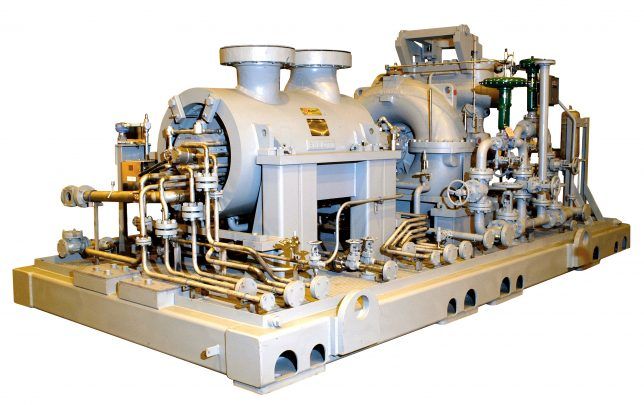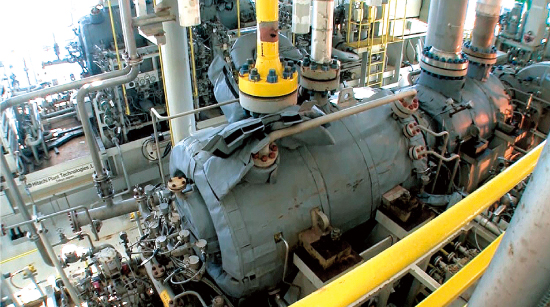BEST OPTION TO SELECT CENTRIFUGAL GAS COMPRESSORS FOR LNG PLANTS

TECHNICAL REQUIREMENTS TO SELECT A CENTRIFUGAL GAS COMPRESSORS IN LNG PLANTS
- Compliance with Standards and Regulations:
- Adherence to international standards and codes specific to gas compressors, such as API (American Petroleum Institute) standards, ISO (International Organization for Standardization) standards, and ASME (American Society of Mechanical Engineers) codes.
- Compliance with relevant safety regulations and guidelines, including those related to hazardous areas, fire protection, and explosion prevention.
- Compliance with environmental regulations, including emissions limits and noise control requirements.
- Design and Construction:
- Robust and reliable design suitable for the demanding operating conditions of an LNG plant, including high-pressure and cryogenic environments.
- Materials selection considering the corrosion resistance required for handling natural gas and other process gases in the LNG plant.
- Compliance with equipment design codes and standards specific to the LNG industry, such as those set by LNG equipment associations and regulatory bodies.
- Consideration of seismic requirements and other site-specific factors.
- Reliability and Availability:
- Proven track record and a history of successful operation in similar LNG plant applications.
- High mean time between failures (MTBF) and low mean time to repair (MTTR) to maximize reliability and minimize downtime.
- Implementation of redundancy and backup systems to ensure continuous operation and minimize the risk of unplanned outages.
- Availability of reliable spare parts and a robust supply chain to support maintenance and repair needs.
- Maintainability:
- Accessibility of key components and ease of maintenance to minimize downtime during planned maintenance activities.
- Availability of technical documentation, including operation manuals, maintenance procedures, and troubleshooting guides.
- Compatibility with condition monitoring systems to enable proactive maintenance and early fault detection.
- Integration with computerized maintenance management systems (CMMS) for efficient maintenance planning and execution.
- Safety and Environmental Considerations:
- Incorporation of safety features, such as emergency shutdown systems, interlocks, and safety instrumented systems (SIS), to prevent accidents and ensure personnel safety.
- Implementation of robust protection systems against fire, explosion, and gas leaks, including gas detection and emergency ventilation.
- Compliance with environmental regulations, including emissions control measures and noise reduction strategies.
- Minimization of potential environmental impacts through the use of efficient designs, waste management practices, and appropriate noise control measures.
- Operational Performance:
- High compression efficiency to maximize the gas compression process efficiency and minimize energy consumption.
- Consideration of turndown capabilities to match varying process demands and maintain stable operation.
- Compatibility with the control and automation systems of the LNG plant, including integration with the distributed control system (DCS) and supervisory control and data acquisition (SCADA) systems.
It is crucial to consult with experienced engineering consultants, equipment manufacturers, and subject matter experts in LNG plant design and operation to ensure compliance with the best international regulations, standards, and current technical specifications. This collaborative approach will help in selecting centrifugal gas compressors that meet the stringent technical requirements for reliability, availability, maintainability, safety, and operational performance, while mitigating safety risks and minimizing environmental impacts in an LNG plant.
LIMITATIONS IN ENGINEERING & DESIGN FOR CENTRIFUGAL COMPRESSORS IN LNG PLNTS
Cost: Engineering and design choices that optimize all desired aspects can sometimes come at a higher cost. Balancing budget constraints with the desired performance and safety features can be a challenge.
Space Limitations: LNG plants often have limited space, and this can impact the selection and arrangement of equipment, including centrifugal gas compressors. Finding an optimal layout that accommodates the required equipment while maintaining accessibility and safety may pose limitations.
Complexity: Achieving the highest level of reliability, availability, and operational performance may require more complex engineering and design solutions. This can lead to increased maintenance and operational complexities, requiring specialized skills and training for the plant operators and maintenance personnel.
System Integration: Integrating the selected centrifugal gas compressors into the overall LNG plant system can present challenges. Ensuring compatibility and seamless integration with other equipment, control systems, and safety systems may require additional engineering effort.
Environmental Constraints: LNG plants operate under stringent environmental regulations. The selection of gas compressors must consider emissions control and noise reduction requirements. Meeting these constraints while maintaining optimal performance can be a limitation in the engineering and design process.
Safety Considerations: While safety is a priority, certain design choices may impact operational performance or efficiency. Balancing safety requirements with performance targets can pose challenges that need careful consideration during the engineering and design phase.
Future Expansion and Flexibility: Anticipating future expansion and changes in operational requirements is essential. Design choices need to be flexible enough to accommodate future modifications or expansions without compromising the reliability, availability, and safety of the gas compressor system.
It is important to engage experienced engineers, design consultants, and equipment manufacturers who have expertise in LNG plant design to navigate these limitations effectively. Their knowledge and experience can help in making informed decisions that strike the right balance between reliability, availability, maintainability, safety, operational performance, environmental impact, and compliance with regulations and standards.

WHY, WHEN, WHERE, WHAT, WHICH AND HOW TO USE CENTRIFUGAL COMPRESSORS IN LNG PLANTS
Why:
- Centrifugal gas compressors are used in LNG plants to compress natural gas for transportation, storage, and liquefaction processes.
- They play a crucial role in maintaining the required pressure levels and flow rates for efficient LNG production and transportation.
When:
- Centrifugal gas compressors are used in LNG plants during various stages, including gas pre-treatment, liquefaction, refrigeration, and regasification processes.
- They are typically installed at different points in the LNG plant, such as inlet compression, boil-off gas compression, and LNG vaporization.
Where:
- LNG plants worldwide utilize centrifugal gas compressors to optimize the efficiency and reliability of the liquefaction and regasification processes.
- They are commonly found in both onshore and offshore LNG facilities.
What:
- Centrifugal gas compressors are mechanical devices that use centrifugal force to compress and raise the pressure of natural gas.
- They consist of key components such as an impeller, diffuser, volute, and various auxiliary systems for lubrication, cooling, and control.
Which:
- Selection of the appropriate centrifugal gas compressor depends on factors such as gas flow rates, pressure ratios, process requirements, and site-specific conditions.
- It is essential to choose a compressor model that meets the specific design parameters and technical specifications outlined by international regulations and standards.
How:
- Engage experienced engineering consultants and equipment suppliers to assess the technical requirements and specifications of the LNG plant.
- Conduct a thorough evaluation of available centrifugal gas compressor options, considering factors such as reliability, availability, maintainability, safety, and operational performance.
- Ensure compliance with international regulations and standards, such as API (American Petroleum Institute) standards and ISO (International Organization for Standardization) codes.
- Conduct detailed engineering and design reviews, including safety and environmental considerations, to select the most suitable centrifugal gas compressor.
- Integrate the selected compressor into the LNG plant system, considering layout, system compatibility, and safety interlocks.
- Follow proper installation, commissioning, and ongoing maintenance practices to ensure optimal performance and reliability.
Remember, the specific details of the why, when, where, what, which, and how of using centrifugal gas compressors in an LNG plant will depend on the unique characteristics and requirements of the plant itself, as well as local regulations and industry best practices. Consulting with experts in LNG plant design and operation is crucial for successful implementation.
PROCEDURES, ACTIONS, STUDIES, ANALYSIS, MITIGATIONS AND RECOMMENDATIONS TO USE CENTRIFUGAL COMPRESSORS IN LNG PLANTS
- Procedures:
- Develop comprehensive procedures for the selection, installation, and operation of centrifugal gas compressors in the LNG plant.
- Establish clear procedures for routine maintenance, inspection, and troubleshooting of compressors.
- Implement proper procedures for start-up, shutdown, and emergency handling of compressors.
- Actions:
- Perform a detailed assessment of the specific process requirements and operating conditions to identify the appropriate compressor specifications and performance criteria.
- Engage qualified engineering consultants and equipment suppliers with expertise in LNG plant design and compressor selection.
- Conduct thorough site assessments to ensure proper foundation and infrastructure for compressor installation.
- Establish a comprehensive maintenance program that includes regular inspections, condition monitoring, and preventive maintenance activities.
- Studies and Analysis:
- Conduct feasibility studies and engineering analyses to determine the optimal compressor size, configuration, and control systems for the LNG plant’s specific requirements.
- Perform system-level simulations and modeling to assess the performance and efficiency of the gas compression process.
- Conduct risk assessments and hazard analyses to identify potential safety risks and develop appropriate mitigation strategies.
- Perform reliability studies, such as failure mode and effects analysis (FMEA), to identify potential failure modes and develop strategies to mitigate them.
- Mitigations:
- Implement redundancy in critical components and systems to ensure continuous operation and minimize the impact of equipment failures.
- Incorporate safety features and systems, such as emergency shutdown systems and gas detection systems, to mitigate safety risks.
- Establish proper ventilation and gas dispersion systems to address potential leakage or release scenarios.
- Implement condition monitoring systems to detect early signs of equipment degradation or impending failures.
- Recommendations:
- Ensure compliance with international regulations, standards, and industry best practices throughout the selection, installation, and operation of centrifugal gas compressors.
- Regularly review and update maintenance procedures based on operational experience and equipment performance.
- Foster a strong safety culture within the LNG plant, promoting proper training, clear communication, and adherence to safety protocols.
- Continuously monitor and evaluate compressor performance, reliability, and efficiency to identify opportunities for improvement and optimization.
It is important to note that the specific procedures, actions, studies, analyses, mitigations, and recommendations will depend on the unique characteristics of the LNG plant, local regulations, and industry best practices. Collaboration with experienced engineering consultants, equipment suppliers, and compliance experts is crucial to ensure the successful implementation of centrifugal gas compressors in an LNG plant while meeting the highest standards of reliability, availability, maintainability, safety, and operational performance while minimizing environmental impacts.
